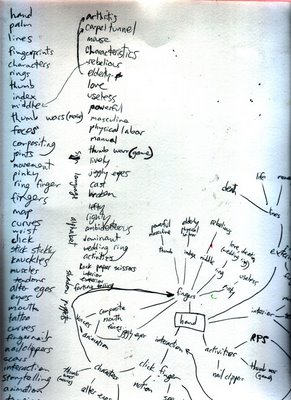Core 3: Advanced Interaction
Wednesday, September 27, 2006
Thursday, September 21, 2006


Wow. Who would've thought - 15 way rock paper scissors!!??? I love this picture, it reminds me a lot of some Indian art that I've seen, like the following image. Heres the link to the site that I found it on, it explains the symbol hierarchy. 15 Way RPS
Wednesday, September 20, 2006


My idea for this project is an interactive online rock paper scissors game. Everybody knows and embraces this age old game, and it is always an easy way to settle any argument. I plan on taking this idea and turning it into a game where you either share something about yourself if you lose, or you are rewarded with a fact about me if you win. It is an interesting interface that will not only be fun, but you will learn about me, and I will learn about the users. In the long run, I would like this project to be connected to a database which stores all of the inputted data, and anyone can view it. The interface will be designed in Flash, and put on the web.
Monday, September 18, 2006




Nam June Paik was one of the most groundbreaking and experimental artists of the 20th century. He was a very versatile artist, but he mostly accredited for his video art work. In his life, he became friends with avante-garde composer John Cage with whom he worked with, and whos work influenced his own. One example of his video art is a film called "Zen for Film". This piece consisted solely of an unexposed film running through a projector. It appears to be a illuminated screen with occasional scratches and film grain made visible. This piece was definitely influenced by John Cage's work, especially his experiments with silence, and the absence of the expected. Nam June Paik's work is always conceptually rich. This piece displays the raw qualities of the medium, and the absence of images is meant to inspire your own internal images. Nam June Paik's work often experiments with television monitors, installations, electronics, and witty concepts. Another one of Nam June Paik's works was an installation called "Something Pacific". This installation consisted of multiple Buddha statues and other well-known figures (Rodin's Thinker) placed in front of dead television sets and other electronic devices. This installation contrasts two very different experiences. These being the contemplative mental states of the statues, and the fast-paced but low-energy mental state of watching television. I find Nam June Paik's concepts in his work to be really interesting. His work has an Asian aesthetic combined with the possibilities of technology, and his own witty touch.
Wednesday, September 13, 2006


Computer games have been continually evolving since they have emerged on our market. During the era of Asteroids, Galaga, and Pong, no one could have possibly imagined how quickly this industry would evolve. Now, games have become so complex that you can control almost every aspect of gameplay, buttons are pressure sensitive, and even the graphics look painstakingly close to real life.
One computer game that I remember playing in my childhood was a game called “Lemmings”. In this game you controlled a tribe of these creatures, and your goal was to get them from one point to another. These Lemmings would walk in a continual path, and the user would control them with a variety of different actions that could be applied to each one. You had to get a certain number of Lemmings to the finish point so that you could move on to the next level. When you applied an action to a Lemming, the Lemming would complete a specific task. Some of these tasks included digging tunnels, building bridges, bombing certain areas, and climbing walls. The format of the game was very linear in multiple aspects. The lemmings always walked on a straight path, and the goal was always the same.
As technology advances, the possibilities of gaming increase exponentially. The more recent game called Warcraft III is based on some of the same principles of Lemmings, but it is much more complex. In Warcraft, your goal is to destroy your enemies in battle, by whatever means possible. While these two games might seem different, they have many similarities. First of all, in both games you are controlling a large group of individual units. Each unit is capable of completing different tasks, and you play the role their leader, controlling everything. Warcraft is a lot less linear than Lemmings in the fact that you can have your units move any direction in a 3D space. Both of these games have a relatively similar interface though. In both, the game play window rests on top of another window that contains commands, a map, and status information. This is essentially where you command your troops in both games. Warcraft’s interface was definitely influenced by Lemmings and other games of a similar vein.
Overall, these two games are an interesting comparison in the evolution of the video game and the virtual environment. There are many similar aspects in both of these games, including the interface, the basic goals, and the way that you interact with the game.

